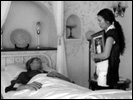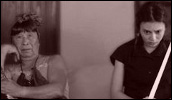Maison de Himiko
- Year
- 2005
- Original title
- Mezon do Himiko
- Japanese title
- メゾン・ド・ヒミコ
- Director
- Cast
- Running time
- 131 minutes
- Published
- 16 January 2007



by Tom Mes
Japan is growing old. With a declining birth rate and growing ranks of the elderly, the prospects for its welfare state, as well as the country's economy as a whole, are looking decidedly shaky. Where under-14s constituted one third of the population at the start of the 20th century, they only represent just over 14% a hundred years later. Predictions say the number will drop as low as 10% in the coming forty years. Developments among over-65s, however, have shown a radically opposite trend: they have gone from a measly 5% in 1900 to a startling 21% today, with an outlook at a whopping 36% by 2050.
Explanations for this phenomenon have been plentiful, including the defeat in World War II and the resulting ruined economy, loveless arranged marriages, the rising cost of living, cramped urban apartments, and the father's absence from the family due to work obligations. Some have even gone so far as to posit an absence of romantic temperament in the character of the Japanese, a view that now seems commonly accepted as the root of the problem by the media, who regularly set out on Oprah Winfrey-like campaigns to help couples rediscover their taste for icha icha and thus boost the nation's fertility rate.
The prospect of a Japan in which the dominant hair colour will be white instead of black is, in short, a major social issue, one that has been feeding the movies for a while already. At least, that part of the film industry that doesn't equate film with fantasies full of idol teens wearing the latest fashions. Makoto Shinozaki's Not Forgotten (Wasurerarenu Hitobito, 2001) tried to build a bridge between the young and the generation of their grandparents, Akira Ogata's excellent The Milkwoman (Itsuka Dokusho Suru Hi, 2005) looked at how the children of the economic miracle - those who are currently in their early fifties - face the fact of their imminent contribution to the aforementioned 36%, while Kiyoshi Kurosawa has been exploring the effects of childlessness on married couples at least as far back as his breakthrough film Cure (1997) and made generation gaps the main theme of his more recent Bright Future (2004). Not to mention of course the more radical nightmare scenario posited in then 70-year-old Kinji Fukasaku's Battle Royale.
Maison de Himiko takes a highly novel point-of-view on the issue by centering its story around a retirement home for elderly gay gentlemen. Helmed as a follow-up to his widely praised Josee, the Tiger and the Fish by Isshin Inudo, one of those quality directors deeply respected in Japan but all but unknown in these parts, it manages the increasingly rare feat of being a mainstream tragicomedy that refuses to resort to quick and easy sentimentality. Saori (Shibasaki) is a young woman who seems to have given up on self-esteem. She is permanently short of cash, screws around with the boss at her part-time job, and spends her lunch breaks leafing through recruitment ads for phone sex workers. One day, handsome Haruhiko (Odagiri) shows up at her workplace, with a peculiar job offer: to come work as a maid at the retirement home where her estranged father (Tanaka) is spending his final days. The old man is dying and bedridden and needs someone to look after him. The pay is good but the prospect puts her off; Saori has never forgiven her father for running out on her mother. That he has been openly gay, going under the name of Himiko and that this dashing young man of her own age is her father's lover only adds insult to injury.
The themes of Maison de Himiko run, as themes tend to do, deeper than the subject of homosexuality alone. The titular retirement home is in many ways an enclave, a safe haven within society at large, where people are allowed to be themselves without fear of judgement or exclusion. Here, the need for tatemae, the public face, has disappeared. Despite her resistance, Saori is to all intents and purposes right at home there, since she too refuses to hide her disillusionments and anger from the real world. Her obstinate behaviour and her refusal to look cute and act proper set her apart from her colleagues at her day job. But where she allows her grudges to isolate her, the inhabitants of the maison refuse to be hemmed in. The film derives much of its power from this investigation into human façades and their purpose. Saori hates her father for abandoning her mother, but fails to take his feelings into account. However, she comes to realize that the bond between her parents was tighter and more complex than she thought, even after their separation, and that it showed an ability to accept and forgive that she never even imagined possible.
Concurrently, Maison de Himiko also views its characters and their choices in life with acceptance and tolerance. It is not free of gay stereotypes, with two of the most enduring putting in appearances: those of the screaming queens and the romanticized pretty boys that are so dear to shojo manga readers. Most of the peripheral characters adhere squarely to the former sort, while Odagiri's is an exponent of the latter tradition. The film nevertheless manages to overcome such stereotyping because in the end we have the impression it cares for the people it depicts. The screenplay gives minor personages a trait or a backstory that allows these men to gain an extra, usually tragic, dimension. While these do feel somewhat obligatory at times, at least solid effort was made to present more than a cardboard cut-out. The actors latch on to these vestiges of humanity, while at the same time relishing the opportunity to run around in pastel frocks. The result, it must be said, is quite infectious.
On the other end of the scale, this motley bunch is balanced out nicely by a pair of grave, dignified performances courtesy of Joe Odagiri and Min Tanaka, who lend an unerringly dark heart to what could otherwise easily have turned into farce. In a role that most young actors with a following of teenage girls to cherish would turn down flat, Odagiri transforms a character cut from the shojo manga mould into another of those enigmatic, troubled souls that are quickly becoming the ubiquitous young thespian's trademark. Tanaka meanwhile, is perhaps the most impressive presence in the film, even though he does little but sit at the sidelines of most scenes and observe. A dancer in real life, Tanaka cuts an imposing figure, giving Himiko a thoroughly unexpected air of unmistakably masculine cool, despite being dressed pretty much exclusively in silken night gowns.
A thoroughly de-glamourised Kou Shibasaki, finally, falls neatly in between these two extremes. For much of the film, she slouches around with a scowl, making no effort to hide her disdain and disgust for this community of queers, but at the same time she gets along with them phenomenally when it comes to boogie-ing down on the dance floor or mimicking characters from TV anime.
Maison de Himiko occasionally strays too far into camp, over-indulging in choreographed dance routines, while a subplot of the reformation of an underage neighbourhood bully comes across as a rather trite and artificial plot twist. On the whole, though, Himiko's house is a pleasant place to while away an hour or two, no matter what your personal inclination may be.